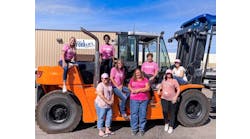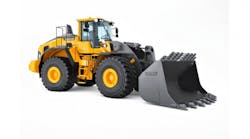To wear or not to wear a safety harness on scissorlifts — if only it was that easy. It sounds like a simple enough question, but ask any two people their recommendations, and you'll likely get two different answers with a lot of good, compelling reasons supporting both sides. It is a question that the industry struggles to reach consensus on.
Everyone agrees that wearing a full body harness with an adjustable-length lanyard set as short as possible is recommended for boom-supported aerial lifts. It is required by both OSHA and the ANSI standards. In a boom-supported platform, the occupants of the platform can be bounced around and possibly projected up and over the guardrails and out of the basket. A boom-supported platform does not have to tip over to have the occupant(s) exposed to a fall hazard. It is the dynamic moment associated with the design of a boomlift that makes the guardrails system around the platform insufficient fall protection. This is the reason why OSHA and ANSI require harnesses on boom-type platforms.
There is universal agreement that harnesses are needed on these machines unless a job-specific risk assessment (such as working over water) says otherwise. But what about fall protection on scissorlifts?
Scissorlifts are not subjected to the same forces as a boomlift, and chances are workers are not going to be catapulted off the deck of a scissorlift. Neither OSHA nor ANSI standards require use of a harness for occupants of scissor platforms. The most likely way a user would fall off a scissors deck is by climbing out or leaning over the guardrails, or if the scissorlift topples over and users go along with it.
Developments in manufacturing design, such as the addition of pothole protection devices, and new standards, such as revised side-pull requirements, have made scissorlifts safer and reduced the number of tipovers. The real cause of many scissorlift accidents is either that operators are simply not following the rules of safe operation or inadequate protection from being struck by vehicles, cranes or objects. No machine design or legislation can overcome stupidity or make individuals comply with existing, appropriate training.
Since climbing out or leaning over the guardrails or the removal of guard rails are not acceptable practice in anyone's book, the debate is really centered on whether a harness will help or hinder you if the machine tips over and you're standing on the platform. Let's look at a few of the arguments on both sides of the question.
Arguments given for wearing harnesses
- Wearing a harness with an appropriate-length lanyard can keep a person from climbing on rails, thus reducing the chances of falling over the railing.
- A scissorlift operator is exposed to the same risk as those working at height, so why not wear a harness?
- If a machine tips over or if the machine were to make a sudden movement, wearing a harness and lanyard may keep a person from being thrown from the platform.
- Since all agree that fall protection must be worn on boomlifts, if harnesses and lanyards were required on scissorlifts, there would be less confusion on the jobsite and everyone would be required to wear the same equipment (only the lanyards might be a different length).
- Oftentimes operators go from working in an overhead location that requires using a boomlift to one that requires them to work from a scissorlift. Since they should already be wearing a harness with a lanyard, it would be more convenient to use them when they got on the scissorlift.
Arguments given for not wearing harnesses
- Many older and some new scissorlifts do not have anchorage points, and OSHA states that guardrails cannot be used as anchorage points, leaving the operator with no place to tie-off safely.
- Lanyards attached to anchorage points on or around the platform deck can present a “tripping hazard” to individuals on the platform if they are too long.
- A harness with an appropriate short-length lanyard is too restricting for an operator to move around the deck and work productively. The operator would have to constantly reposition the lanyard.
- If the scissorlift were to tip over, wearing a harness and lanyard doesn't allow the operator to jump off or hold onto something overhead to keep from falling to the ground with the machine.
- If the operator wishes to slide the deck in or out, then they will need to disconnect and re-connect their lanyard each time.
- If the operator wearing a harness and lanyard was to fall from an upright scissorlift, the increased side-pull when the lanyard stops his fall could cause the scissorlift to tip over.
- If a machine were to tip over, a harness and lanyard will keep the operator tied to the platform and may cause him to make contact with or swing under the platform or scissor stack as it falls.
- If you wear a harness and lanyard on a large scissor and you want to see behind the machine before reversing, you need to either lean out over both sides or disconnect the lanyard and walk around the platform to make sure the area is clear. This can cause a safety problem if the operator doesn't take the time to look.
- An operator wearing a harness and lanyard can have a false sense of security and think that he is protected from harm if he falls, which can lead to careless behavior.
- If OSHA and ANSI do not require their use on scissors, why should you?
The Advisory Council of AWPT has met a number of times to discuss the many pros and cons of wearing a harness and lanyard on scissorlifts, and the organization has authored its Technical Guidance Note H1 to address the use of personal fall protection on aerial work platforms. This was issued Jan. 6, 2007, and may be seen at the awpt.org website.
Although AWPT and IPAF do not favor the wearing of harnesses on scissorlifts, we want to hear your thoughts. Do you have any additional harness arguments? Do you understand the current regulations? Do you think the use of harnesses should be mandated?
If you haven't reached any final conclusions as to whether or not you should wear a harness on a scissorlift, when in question, there is always one rule to fall back on. The use of safety harnesses and an appropriate lanyard should always follow a job-specific risk assessment and abide by all local regulations, employer guidelines and manufacturer recommendations.
Tony Groat is executive vice president of Aerial Work Platform Training (AWPT). Groat joined AWPT after a 31-year career in the rental industry, most recently as regional vice president of NES Rentals. For more information, visit www.awpt.org.


